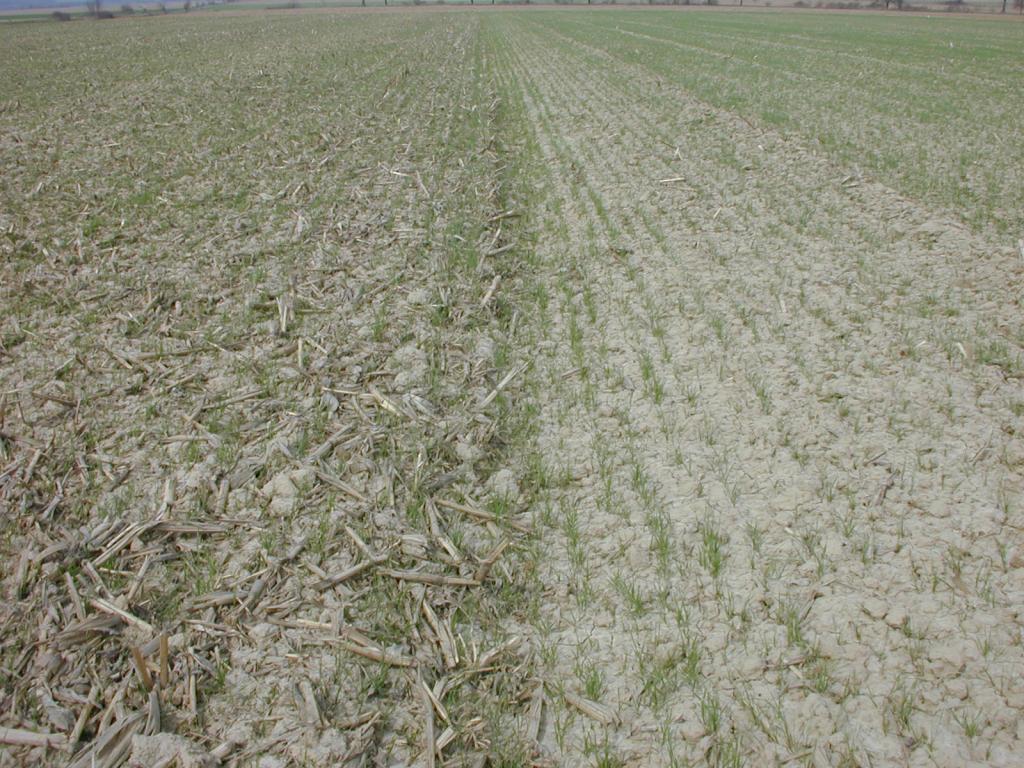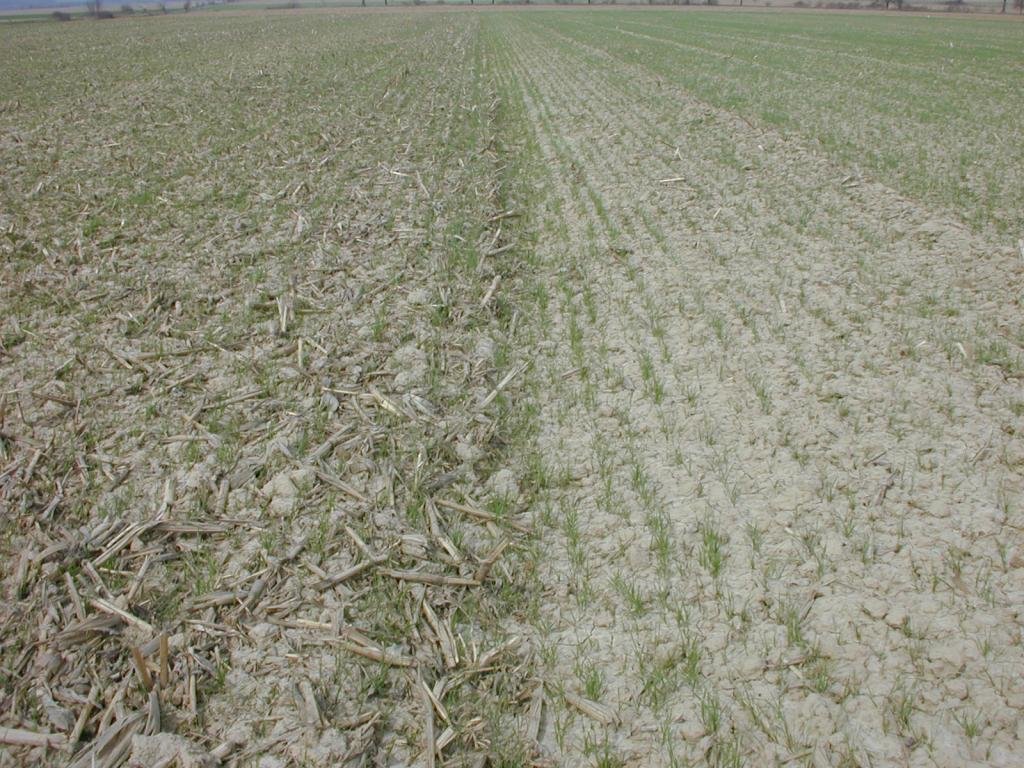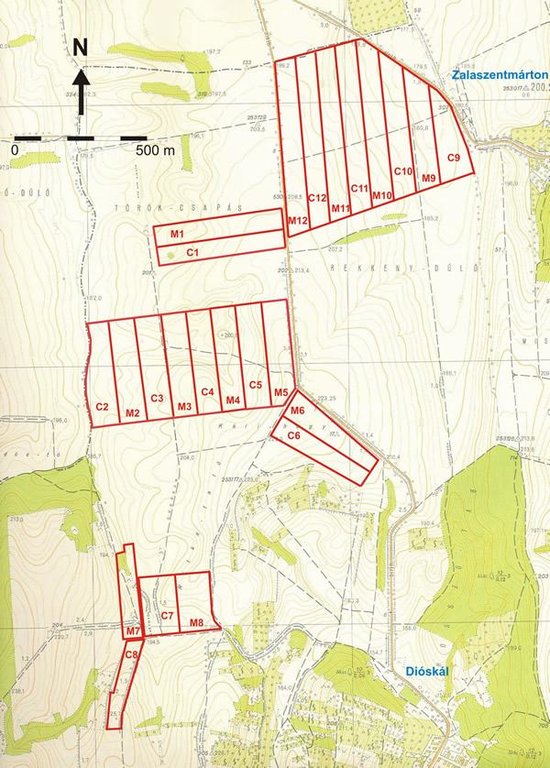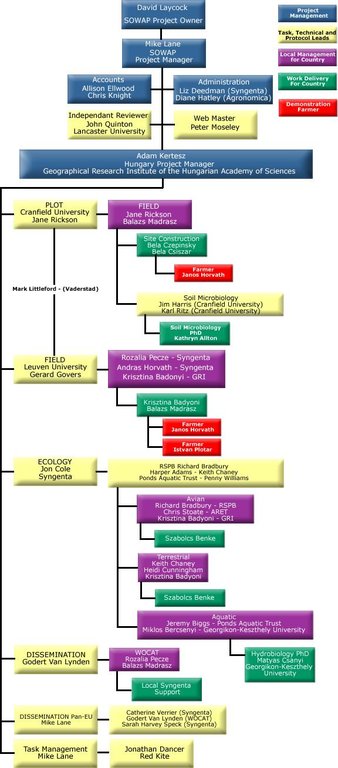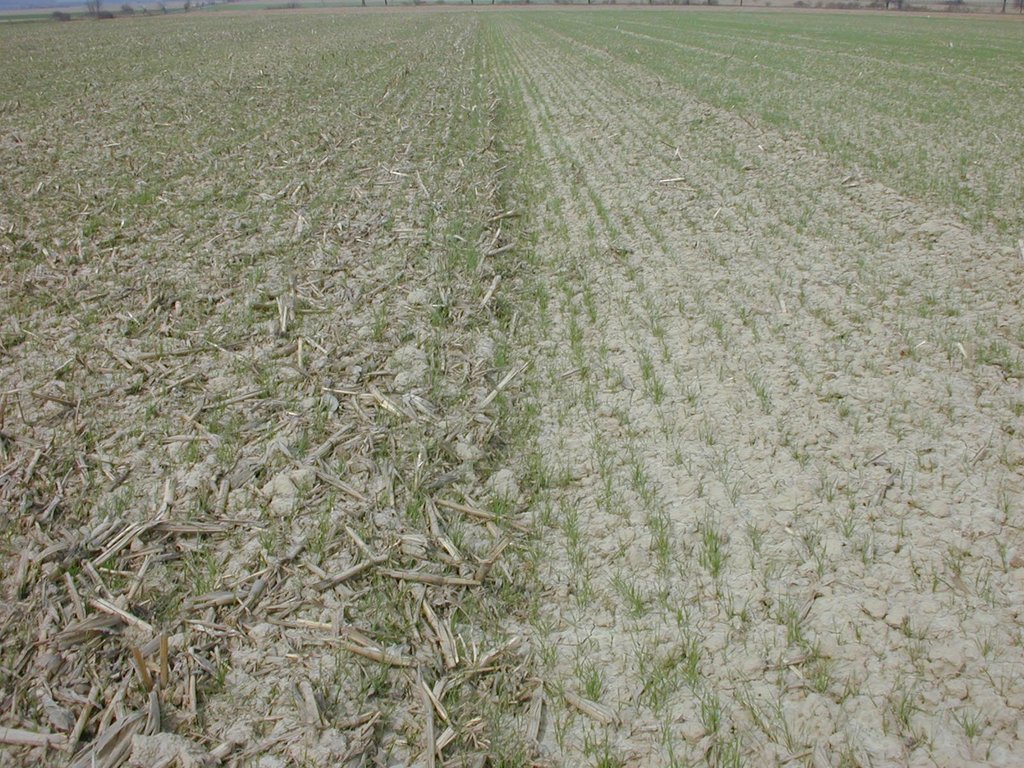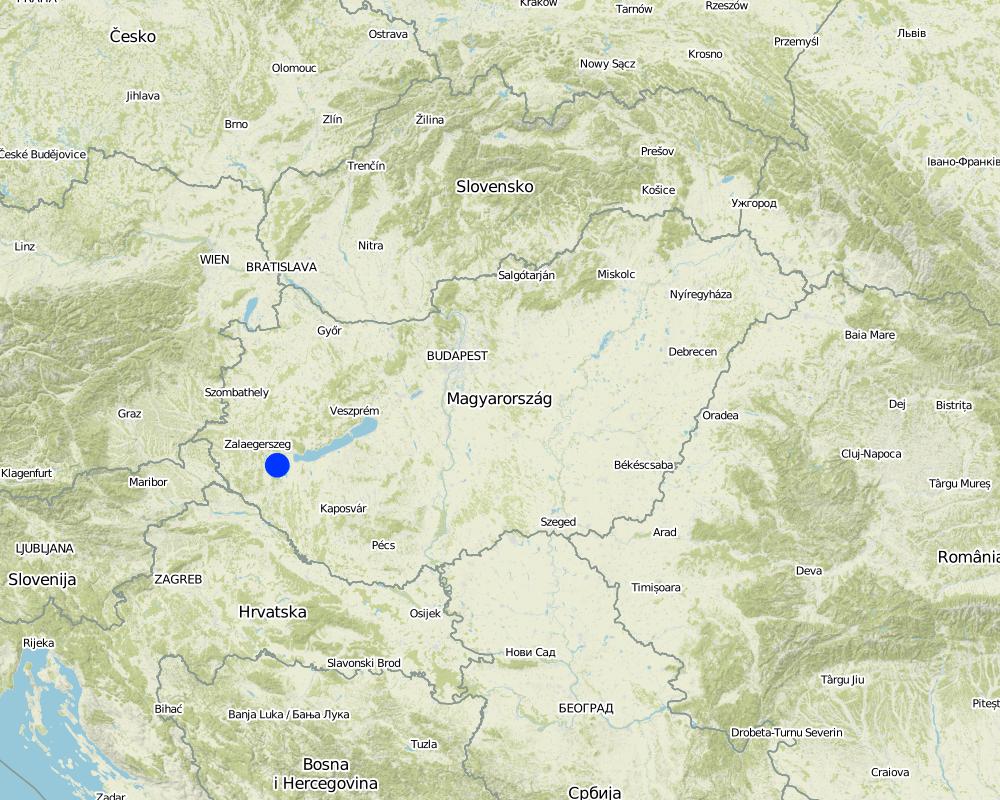Conservation tillage [ប្រទេសហុងគ្រី]
- ការបង្កើត៖
- បច្ចុប្បន្នភាព
- អ្នកចងក្រង៖ Adam Kertesz
- អ្នកកែសម្រួល៖ –
- អ្នកត្រួតពិនិត្យ Fabian Ottiger
approaches_2552 - ប្រទេសហុងគ្រី
ពិនិត្យមើលគ្រប់ផ្នែក
ពង្រីកមើលទាំងអស់ បង្រួមទាំងអស់1. ព័ត៌មានទូទៅ
1.2 ព័ត៌មានលម្អិតពីបុគ្គលសំខាន់ៗ និងស្ថាប័នដែលចូលរួមក្នុងការវាយតម្លៃ និងចងក្រងឯកសារនៃវិធីសាស្ត្រផ្សព្វផ្សាយ
អ្នកជំនាញឯកទេស SLM:
ឈ្មោះអង្គភាពមួយ (ច្រើន) ដែលបានចងក្រងឯកសារ/ វាយតម្លៃលើវិធីសាស្ត្រផ្សព្វផ្សាយ (បើទាក់ទង)
Geographical Research Institute, Hungarian Academy of Sciences (MTA CSFK) - ប្រទេសហុងគ្រី1.3 លក្ខខណ្ឌទាក់ទងទៅនឹងការប្រើប្រាស់ទិន្នន័យដែលបានចងក្រងតាមរយៈវ៉ូខេត
អ្នកចងក្រង និង(បុគ្គលសំខាន់ៗ)យល់ព្រមទទួលយកនូវលក្ខខណ្ឌនានាទាក់ទងទៅនឹងការប្រើប្រាស់ទិន្នន័យដែលបានចងក្រងតាមរយៈ វ៉ូខេត:
បាទ/ចា៎
1.4 ការយោងមួយ (ច្រើន) ទៅលើ (កម្រង) បញ្ជីសំណួរនៃបច្ចេកទេស SLM

Controlled traffic farming [ប្រទេសហុងគ្រី]
All machinery traffic uses the same lane network within the field to reduce the total compacted area, to improve connections, and to optimise overlapping of following runs resulting in more efficient use of labour and inputs. Risks from environmental pollution are also reduced.
- អ្នកចងក្រង៖ Brigitta Szabó

Conservation tillage [ប្រទេសហុងគ្រី]
The aim of conservation tillage is to reduce the soil disturbance. It decreases decomposition of organic matter, enhances cycling of nutrients, soil structure and increases water infiltration.
- អ្នកចងក្រង៖ Brigitta Toth
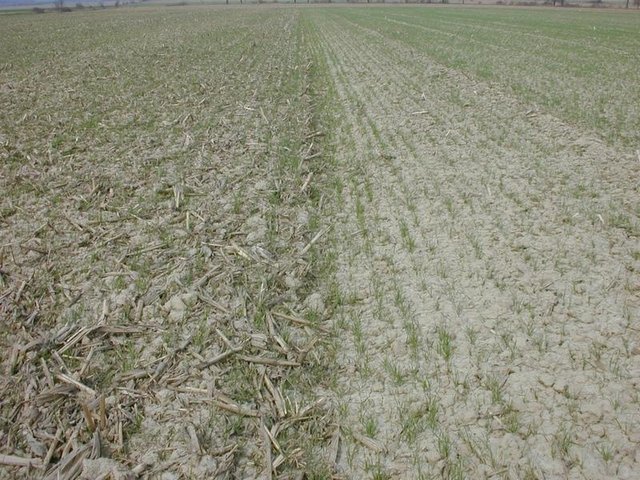
Conservation tillage [ប្រទេសហុងគ្រី]
Non inversion, conservation (soil and water protective) tillage.
- អ្នកចងក្រង៖ Ádám Kertész
2. ការពណ៌នាអំពីវិធីសាស្ត្រផ្សព្វផ្សាយ SLM
2.1 ពណ៌នាសង្ខេបខ្លីពីវិធីសាស្ត្រផ្សព្វផ្សាយ
Non inversion, conservation (soil and water protective) tillage.
2.2 ពណ៌នាលម្អិតពិវិធីសាស្ត្រផ្សព្វផ្សាយ
ពណ៌នាលម្អិតពិវិធីសាស្ត្រផ្សព្វផ្សាយ:
Aims / objectives: Purpose: Finding and Demonstrating Ways of Better Managing the Land. SOWAP (SOil and WAter Protection) aims to assess the viability of a more 'conservation-oriented' agriculture, where fewer tillage practices replace the numerous cultivations carried out under more 'conventional' arable farming systems. The use of appropriate chemicals is tested, and their potential for off-site contamination assessed, to ensure that any suggested approaches are environmentally sound. Conventional tillage is an environment friendly method, carried out by shallow tillage (with disks and direct drill) and omission of ploughing (non-inversion).
Stages of implementation: Shallow disking, direct drill, environment friendly plant-protecting materials.
2.3 រូបភាពនៃវិធីសាស្ត្រផ្សព្វផ្សាយ
2.5 ប្រទេស/តំបន់/ទីតាំងកន្លែង ដែលវិធីសាស្ត្រផ្សព្វផ្សាយត្រូវបានអនុវត្តន៍
ប្រទេស:
ប្រទេសហុងគ្រី
តំបន់/រដ្ឋ/ខេត្ត:
Zala county
Map
×2.6 កាលបរិច្ឆេទនៃការចាប់ផ្តើម និងបញ្ចប់នៃវិធីសាស្រ្តផ្សព្វផ្សាយនេះ
សូមបញ្ជាក់ឆ្នាំដែលបានបង្កើតឡើង:
2003
2.7 ប្រភេទនៃវិធីសាស្ត្រផ្សព្វផ្សាយ
- ផ្អែកលើគម្រោង/កម្មវិធី
2.8 គោលបំណង/ទិសដៅសំខាន់នៃវិធីសាស្ត្រផ្សព្វផ្សាយ
The Approach focused mainly on SLM with other activities (ecology, economics, EU and national rules and regulations)
Soil and water protection (soil loss reduction), biodiversity enhancement, Finding and Demonstrating Ways of Better Managing the Land., Finding an environment friendly technology.
The SLM Approach addressed the following problems: deffence against soil compaction
2.9 លក្ខខណ្ឌអនុញ្ញាត ឬរារាំងការអនុវត្តន៍បច្ចេកទេសដែលស្ថិតនៅក្រោមវិធីសាស្រ្តផ្សព្វផ្សាយ
ភាពអាចរកបាននៃធនធានហិរញ្ញវត្ថុ និងសេវាកម្ម
- រារាំង
purchase new machines
Treatment through the SLM Approach: It is easier to get financial support if you apply modern technologies
ក្របខណ្ឌច្បាប់ (សិទ្ធិកាន់កាប់ដីធ្លី កម្មសិទ្ធីប្រើប្រាស់ដីនិងទឹក)
- អំណោយផល
The existing land ownership, land use rights / water rights moderately helped the approach implementation
3. ការចូលរួម និងតួនាទីរបស់ភាគីពាក់ព័ន្ធ
3.1 អ្នកពាក់ព័ន្ធដែលបានចូលរួមក្នុងវិធីសាស្ត្រផ្សព្វផ្សាយ និងតួនាទីរបស់ពួកគេ
- អ្នកប្រើប្រាស់ដីក្នុងតំបន់/សហគមន៍
Working land users were work equally divided between men and women (1 family (3 persons))
- អ្នកឯកទេសគ្រប់គ្រងដីប្រកបដោយចីរភាព/ទីប្រឹក្សាបច្ចេកទេសកសិកម្ម
Reserach Institute
- រដ្ឋាភិបាលថ្នាក់ជាតិ (អ្នករៀបចំផែនការ អ្នកសម្រេចចិត្ត)
- អង្គការអន្តរជាតិ
- The SOWAP project
3.2 ការចូលរួមរបស់អ្នកប្រើប្រាស់ដីក្នុងតំបន់/ សហគមន៍ក្នុងតំបន់ក្នុងដំណាក់កាលផ្សេងគ្នានៃវិធីសាស្រ្តផ្សព្វផ្សាយ
| ការចូលរួមរបស់អ្នកប្រើប្រាស់ដីក្នុងតំបន់/សហគមន៍ក្នុងតំបន់ | សូមបញ្ជាក់នរណាត្រូវបានចូលរួម ព្រមទាំងពណ៌នាសកម្មភាពទាំងនោះ | |
|---|---|---|
| ការចាប់ផ្តើម/ការលើកទឹកចិត្ត | អសកម្ម | Mainly:rapid/participatory rural appraisal; partly: public meetings; 1 family was choosen (on the basis of suitable land size, machines etc.) |
| ការរៀបចំផែនការ | អន្តរកម្ម | workshops/seminars |
| ការអនុវត្តន៍ | អន្តរកម្ម | responsibility for major steps |
| ការត្រួតពិនិត្យ និងវាយតម្លៃ | អសកម្ម | interviews/questionnaires; |
| Research | គ្មាន |
3.4 ការសម្រេចចិត្តលើការជ្រើសរើសបច្ចេកទេស SLM
សូមបញ្ជាក់តើអ្នកណាជាអ្នកបានសម្រេចចិត្តក្នុងការជ្រើសរើសបច្ចេកទេសដើម្បីយកមកអនុវត្តន៍:
- អ្នកជំនាញឯកទេស SLM បន្ទាប់ពីបានប្រឹក្សាយោបល់ជាមួយអ្នកប្រើប្រាស់ដី
ចូរពន្យល់:
Decisions on the method of implementing the SLM Technology were made by mainly by SLM specialists with consultation of land users
4. ជំនួយបច្ចេកទេស ការកសាងសមត្ថភាព និងការគ្រប់គ្រងចំណេះដឹង
4.1 ការកសាងសមត្ថភាព/ បណ្តុះបណ្តាល
តើវគ្គបណ្តុះបណ្តាលបានផ្តល់ឱ្យអ្នកប្រើប្រាស់ដី/អ្នកពាក់ព័ន្ធផ្សេងៗទៀតដែរឬទេ?
បាទ/ចា៎
សូមបញ្ជាក់តើអ្នកណាត្រូវបានបណ្តុះបណ្តាល:
- អ្នកប្រើប្រាស់ដី
- SWC specialists, politicians/decision makers
ទម្រង់នៃការបណ្តុះបណ្តាល:
- អនុវត្តន៍ជាមួយការងារ
- ពីកសិករទីកសិករ
- ការប្រជុំជាសាធារណៈ
ប្រធានបទបណ្តុះបណ្តាល:
methods of conservation tillage, conservation tillage in UK
4.2 សេវាផ្តល់ប្រឹក្សាយោបល់
តើអ្នកប្រើប្រាស់ដីបានទទួលនូវសេវាផ្តល់ប្រឹក្សាដែរ ឬទេ?
បាទ/ចា៎
ពណ៌នា/ពន្យល់:
Name of method used for advisory service: Conservation tillage (Soil and Water Protection); 1) Advisory service was carried out through: projects own extension structure and agents; Extension staff: members f the SOWAP project 2) Target groups for extension: land users; Activities: field visit and meetings
Advisory service is quite adequate to ensure the continuation of land conservation activities
4.3 ការពង្រឹងសមត្ថភាពស្ថាប័ន (ការអភិរឌ្ឍន៍អង្គភាព)
តើស្ថាប័នទាំងអស់ត្រូវបានបង្កើតឡើង ឬពង្រឹងសមត្ថភាពតាមរយៈវិធីសាស្ត្រផ្សព្វផ្សាយដែរ ឬទេ?
- ទេ
4.4 ការត្រួតពិនិត្យ និងវាយតម្លៃ
តើការត្រួតពិនិត្យ និងវាយតម្លៃគឺជាផ្នែកមួយនៃវិធីសាស្ត្រដែរឬទេ?
បាទ/ចា៎
មតិយោបល់:
bio-physical aspects were regular monitored through measurements
technical aspects were regular monitored through measurements
economic / production aspects were regular monitored through measurements
no. of land users involved aspects were regular monitored through observations
management of Approach aspects were regular monitored through observations
There were few changes in the Approach as a result of monitoring and evaluation: If the soil is very compact the direct drilling is impossible therfore preliminary disking is necessary.
4.5 ការស្រាវជ្រាវ
តើការស្រាវជ្រាវ គឺជាផ្នែកមួយនៃវិធីសាស្រ្តដែរឬទេ?
បាទ/ចា៎
សូមផ្តល់ព័ត៌មានបន្ថែមទៀតឱ្យបានលម្អិត និងចង្អុលបង្ហាញនរណាដែលបានធ្វើការស្រាវជ្រាវ:
Nevertheless this project includes natural and socio-economic aspects.
Research was carried out both on station and on-farm
5. ថវិកា និងសម្ភារៈឧបត្ថម្ភពីខាងក្រៅ
5.1 ថវិកាប្រចាំឆ្នាំសម្រាប់ផ្សព្វផ្សាយ SLM
មតិយោបល់ (ឧ. ប្រភពសំខាន់នៃមូលនិធិ/ម្ចាស់ជំនួយចំបង):
Approach costs were met by the following donors: international (EU-Life foundation): 50.0%; international non-government (Syngenta Ltd.): 50.0%
5.2 ការគាំទ្រផ្នែកហិរញ្ញវត្ថុ / សម្ភារៈដែលបានផ្តល់ទៅឱ្យអ្នកប្រើប្រាស់ដី
តើអ្នកប្រើប្រាស់ដីបានទទួលការគាំទ្រផ្នែកហិរញ្ញវត្ថ/សម្ភារៈសម្រាប់ការអនុវត្តន៍បច្ចេកទេសដែរឬទេ:
បាទ/ចា៎
5.3 សូមបញ្ជាក់ពីធាតុចូលត្រូវបានផ្តល់បដិភាគ (រួមទាំងកម្លាំងពលកម្ម)
- សម្ភារៈ
| សូមបញ្ជាក់ ធាតុចូលណាខ្លះដែលបានផ្តល់បដិភាគ | កម្រិតទំហំប៉ុណ្ណា | សូមបញ្ជាក់ពីការបដិភាគ |
|---|---|---|
| ម៉ាស៊ីន | ផ្តល់ហិរញ្ញវត្ថុមួយផ្នែក | |
| ឧបករណ៍ | ផ្តល់ហិរញ្ញវត្ថុមួយផ្នែក | |
- កសិកម្ម
| សូមបញ្ជាក់ ធាតុចូលណាខ្លះដែលបានផ្តល់បដិភាគ | កម្រិតទំហំប៉ុណ្ណា | សូមបញ្ជាក់ពីការបដិភាគ |
|---|---|---|
| គ្រាប់ពូជ | ផ្តល់ហិរញ្ញវត្ថុមួយផ្នែក | |
| ជី | ផ្តល់ហិរញ្ញវត្ថុមួយផ្នែក | |
| Biocides | ផ្តល់ហិរញ្ញវត្ថុមួយផ្នែក | |
ប្រសិនបើកម្លាំងពលកម្មធ្វើដោយអ្នកប្រើប្រាស់ដី តើវាជាធាតុចូលដ៏សំខាន់មួយដែរ ឬទេ:
- បង់ជាសាច់ប្រាក់
5.4 ឥណទាន
តើឥណទានដែលបានផ្តល់នៅក្រោមវិធីសាស្ត្រផ្សព្វផ្សាយសម្រាប់សកម្មភាព SLM នេះយ៉ាងដូចម្តេច?
ទេ
6. ការវិភាគរកផលប៉ះពាល់ និងសេចក្តីសន្និដ្ឋាន
6.1 ផលប៉ះពាល់នៃវិធីសាស្ត្រផ្សព្វផ្សាយ
តើវិធីសាស្ត្រផ្សព្វផ្សាយជួយអ្នកប្រើប្រាស់ដីដើម្បីអនុវត្តន៍ និងថែទាំបច្ចេកទេស SLM?
- ទេ
- បាទ/ច៎ា បន្តិចបន្តួច
- បាទ/ច៎ា ជាមធ្យម
- បាទ/ច៎ា បានខ្លាំង
demonstrations, meetings, articles, publications, TV films.
Did other land users / projects adopt the Approach?
- ទេ
- បាទ/ច៎ា បន្តិចបន្តួច
- បាទ/ច៎ា ជាមធ្យម
- បាទ/ច៎ា បានខ្លាំង
A couple of land users keep trying this method because it reduces theire costs.
6.3 សកម្មភាពផ្សព្វផ្សាយដែលប្រកបដោយចីរភាព
តើអ្នកប្រើប្រាស់ដីអាចធ្វើឱ្យមានចីរភាពនូវអ្វីដែលត្រូវបានអនុវត្តន៍តាមរយៈវិធីសាស្ត្រផ្សព្វផ្សាយដែរឬទេ(ដោយពុំមានការគាំទ្រពីអ្នកខាងក្រៅ)?
- បាទ/ចា៎
6.4 ភាពខ្លាំង/ គុណសម្បត្តិនៃវិធីសាស្ត្រផ្សព្វផ្សាយ
| ភាពខ្លាំង/ គុណសម្បត្តិ/ ឱកាស ទស្សនៈរបស់អ្នកប្រើប្រាស់ដី |
|---|
| future subsidy expectations and better chance for competition |
| soil loss reduction |
| economicalness |
| environmental consciousness agriculture |
| ភាពខ្លាំង/ គុណសម្បត្តិ/ ឱកាស ទស្សនៈរបស់បុគ្គលសំខាន់ៗ |
|---|
| soil loss reduction |
| biodiversity enhancement |
| spreading of environmental conscious agriculture |
| soil and water protection |
| economicalness |
6.5 ភាពខ្សោយ/ គុណវិបត្តិនៃវិធីសាស្ត្រ និងរកដំណោះស្រាយ
| ភាពខ្សោយ/ គុណវិបត្តិ/ ហានិភ័យ ទស្សនៈរបស់អ្នកប្រើប្រាស់ដី | តើបច្ចេកទេសទាំងនោះបានដោះស្រាយបញ្ហាដូចម្តេច? |
|---|---|
| reduced production (yield) | |
| expensive machines |
| ភាពខ្សោយ/ គុណវិបត្តិ/ ហានិភ័យក្នុងទស្សនៈរបស់បុគ្គលសំខាន់ៗ | តើបច្ចេកទេសទាំងនោះបានដោះស្រាយបញ្ហាដូចម្តេច? |
|---|---|
| Too many tools are required. Expensive machines. |
7. ឯកសារយោង និងវេបសាយ
7.1 វិធីសាស្ត្រ/ ប្រភពនៃព័ត៌មាន
- តាមការចុះទីវាល ការស្រាវជ្រាវនៅទីវាល
- ការសម្ភាសន៍ជាមួយអ្នកប្រើប្រាស់ដី
7.2 ឯកសារយោងដែលបានចេញផ្សាយ
ចំណងជើង អ្នកនិពន្ធ ឆ្នាំ ISBN:
BIRKÁS, M. (2002): Környezetkímélö és energiatakarékos talajméelés.
មានប្រភពមកពីណា? ថ្លៃដើមប៉ុន្មាន?
SZIE, Mezógazdasági és Környezettudományi Kar, Gödöllö, 345 p.
ចំណងជើង អ្នកនិពន្ធ ឆ្នាំ ISBN:
HOLLAND, J.M. (2004): The environmental consequences of adopting conservation tillage in Europe: reviewing the evidence.
មានប្រភពមកពីណា? ថ្លៃដើមប៉ុន្មាន?
Agriculture Ecosystems & Environment, Vol. 103. No. 1., pp. 1-25.
ចំណងជើង អ្នកនិពន្ធ ឆ្នាំ ISBN:
Talajkímúlö múvelés és környezetvédelem
មានប្រភពមកពីណា? ថ្លៃដើមប៉ុន្មាន?
Gyakorlati Agrofórum Extra 3.
ចំណងជើង អ្នកនិពន្ធ ឆ្នាំ ISBN:
BIRKÁS, M., JOLÁNKAI, M., GYURICZA, CS., PERCZE, A. (2004): Tillage effects on compaction, earthworms and other soil quality indicators in Hungary.
មានប្រភពមកពីណា? ថ្លៃដើមប៉ុន្មាន?
Soil & Tillage Research, Vol. 78. No. 2., pp. 185-196.
ចំណងជើង អ្នកនិពន្ធ ឆ្នាំ ISBN:
MANNINGER, G. A. (1957): A talaj sekély múvelése.
មានប្រភពមកពីណា? ថ្លៃដើមប៉ុន្មាន?
Mezógazdasági Kiadó, Budapest, 135 p.
ការតភ្ជាប់ និងម៉ូឌុល
ពង្រីកមើលទាំងអស់ បង្រួមទាំងអស់ការតភ្ជាប់

Controlled traffic farming [ប្រទេសហុងគ្រី]
All machinery traffic uses the same lane network within the field to reduce the total compacted area, to improve connections, and to optimise overlapping of following runs resulting in more efficient use of labour and inputs. Risks from environmental pollution are also reduced.
- អ្នកចងក្រង៖ Brigitta Szabó

Conservation tillage [ប្រទេសហុងគ្រី]
The aim of conservation tillage is to reduce the soil disturbance. It decreases decomposition of organic matter, enhances cycling of nutrients, soil structure and increases water infiltration.
- អ្នកចងក្រង៖ Brigitta Toth

Conservation tillage [ប្រទេសហុងគ្រី]
Non inversion, conservation (soil and water protective) tillage.
- អ្នកចងក្រង៖ Ádám Kertész
ម៉ូឌុល
គ្មានម៉ូឌុល


